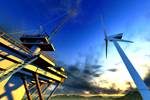Vestas EnVentus order, Minnesota Power proposal advance U.S. wind capacity
In November, Vestas secured a 300-MW order for the Illinois-based Goose Creek Wind farm, and Minnesota Power doubled its wind energy proposal to 400 MW, projects which are aiming for 100% clean energy for each state by 2050.

V162-6.2 MW EnVentus platform. Photo Credit: Vestas
According to the U.S. Department of Energy’s (DOE) , the “U.S. wind industry installed 13,413 megawatts (MW) of new wind capacity in 2021, bringing the cumulative total to 135,886 MW,” making it the second highest amount of wind capacity installed in one year (after 2020). New developments in the U.S. released from (Portland, Ore., U.S.) and electric utility company (Duluth) continue this trend, both of which have a goal to reach 100% clean energy by 2050.
On Nov. 9, Vestas received a 300-MW order from Apex Clean Energy (Charlottesville, Va., U.S.) to power the Goose Creek Wind project in Illinois. The order consists of Vestas’ 50 V162-6.2 MW delivered in 6.0-MW operating mode, and includes supply, delivery and commissioning of the turbines, as well as a 10-year active output management 5000 (AOM 5000) service agreement, designed to ensure optimized performance of the asset.
The project will support nearly 400 construction jobs, eight long-term positions and approximately $200 million in tax revenue and landowner payments in Illinois.
Turbine delivery begins in the third quarter of 2023 with commissioning scheduled for the fourth quarter of 2023.
Minnesota Power, a utility division of Allete Inc., is advancing its own EnergyForward plan by significantly increasing the amount of renewable energy it provides over the next 15 years, based on an agreement reached with stakeholder groups, as of Nov. 8.
In a letter filed with the Minnesota Public Utilities Commission as part of the Integrated Resource Plan (IRP) proceedings, Minnesota Power said it will seek up to 400 MW of wind energy and 300 MW of regional solar energy. This is nearly double what the company proposed in its initial IRP filing, which called for the company to add 200 MW of wind and 200 MW of solar as part of its EnergyForward blueprint for achieving 100% carbon-free energy by 2050.
“Before and during the state’s IRP process, we have prioritized listening and taking feedback from customers, communities and organizations that will benefit from our clean energy transition for all,” Minnesota Power COO Josh Skelton says. “We are pleased that we could work with these stakeholders to reach an agreement that allows us to continue on our path to a carbon-free supply while also protecting safe and reliable energy at competitive rates.”
The Minnesota Public Utilities Commission will consider the next steps in Minnesota Power’s EnergyForward plan as it holds two hearings to discuss the details of the company’s IRP. The commission was expected to vote on the IRP on Nov. 22, including the agreement reached on increasing renewables.
If approved, under the agreement Minnesota Power will advance storage projects that support investment in its renewable portfolio and continue to evaluate the transition of Boswell Energy Center (Boswell Unit 3 will cease coal operations by 2030). Other resource considerations, including electric grid strengthening proposals such as the MISO Long-Range Transmission Plan and a previously approved natural gas power plant, have been deferred until future regulatory filings.
Related Content
-
Ceramic matrix composites: Faster, cheaper, higher temperature
New players proliferate, increasing CMC materials and manufacturing capacity, novel processes and automation to meet demand for higher part volumes and performance.
-
Plant tour: Hexagon Purus, Kassel, Germany
Fully automated, Industry 4.0 line for hydrogen pressure vessels advances efficiency and versatility in small footprint for next-gen, sustainable composites production.
-
Achieving composites innovation through collaboration
Stephen Heinz, vice president of R&I for Syensqo delivered an inspirational keynote at SAMPE 2024, highlighting the significant role of composite materials in emerging technologies and encouraging broader collaboration within the manufacturing community.






